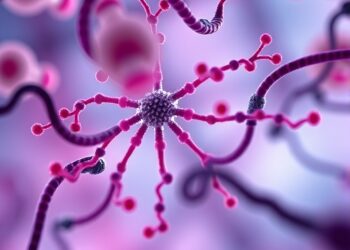University of Arizona Researchers Harness AI to Unlock the Structural Secrets of Tumor-Rejecting Neoantigens in Skin Cancer
In a groundbreaking advancement in cancer immunotherapy, scientists at the University of Arizona have unveiled a novel approach to identifying and characterizing neoantigens—mutated tumor proteins that potentially serve as critical targets for personalized cancer vaccines. Their recent study, focusing on cutaneous squamous cell carcinoma (cSCC), a common and sometimes aggressive form of skin cancer, combines computational modeling with innovative artificial intelligence (AI) methods to decode how structural attributes of neoantigens influence immune recognition and tumor rejection.
Tumor neoantigens arise from genetic mutations unique to cancer cells and do not exist in normal tissues, making them ideal “flags” for the immune system to differentiate malignant cells from healthy ones. These mutated peptides, when presented on the surface of tumor cells via the major histocompatibility complex (MHC), can activate T cells, pivotal players in adaptive immunity that orchestrate targeted destruction of cancerous cells. However, one of the biggest challenges in the development of cancer vaccines lies in discerning which neoantigens will effectively stimulate a T cell response potent enough to eradicate tumors.
The research team, led by Dr. Karen Taraszka Hastings, Chair of Dermatology at the University of Arizona College of Medicine – Phoenix, developed a sophisticated mouse model mimicking human cSCC. This model revealed an unexpectedly high burden of tumor mutations, mirroring genetic alterations seen in both human patients and laboratory mice. Within this plethora of mutations, two neoantigens stood out—derived from mutations in the Picalm and Kars proteins—that independently provoked robust anti-tumor T cell responses, arresting tumor progression in vivo.
Detailed immunological analyses illuminated fascinating mechanistic differences between these two neoantigens. The mutated Picalm peptide displayed a striking capacity to bind the MHC molecules, a prerequisite for T cell recognition, whereas its normal, non-mutated counterpart failed to achieve such MHC presentation. This discrepancy elucidates why mutated Picalm effectively alerts the immune system while the wild-type version does not. In contrast, the mutated and normal versions of the Kars peptide showed similar binding affinities to MHC, suggesting that differential MHC presentation alone could not explain the enhanced immune response against mutated Kars.
To resolve this conundrum, the scientists turned to cutting-edge AI-powered, three-dimensional structural modeling of the neoantigen-MHC complexes. This computational approach revealed subtle but critical conformational changes on the surface of the mutated Kars peptide exposed to the T cell receptor. These structural modifications alter the chemical landscape perceived by T cells, triggering a targeted immune response capable of tumor control. This finding underscores the importance of considering the three-dimensional architecture—not just peptide sequence or MHC binding affinity—when predicting which neoantigens will be immunogenic.
Building on these insights, the researchers conducted comprehensive analyses across an array of known neoantigens individually assessed for tumor control efficacy in experimental settings. They found a consistent pattern: effective tumor-rejecting neoantigens exhibited increased surface exposure of mutated residues accessible to T cell receptors, reaffirming the pivotal role of structural presentation in anti-cancer immunity.
Dr. Hastings emphasizes the transformative potential of integrating AI-driven structural modeling into neoantigen discovery pipelines. “Our approach offers a refined lens to select the most promising neoantigens for inclusion in personalized cancer vaccines, especially for highly mutated tumors such as those arising in skin cancers and melanoma,” she explained. By precisely predicting T cell-activating neoantigens, this methodology could drastically enhance vaccine specificity and effectiveness, streamlining therapeutic development pathways.
Moreover, the team’s interdisciplinary collaboration—spanning computational biology, immunology, and dermatology—exemplifies the convergence of data science and clinical research in modern medicine. David Ebert, Chief AI and Data Science Officer at the University of Arizona, hailed the study as a prime example of AI’s impact in revolutionizing cancer therapeutics. The integration of machine learning algorithms with molecular biology has paved the way for novel diagnostic and treatment modalities poised to revolutionize patient care.
Looking ahead, the researchers plan to validate their findings using human tumor samples, aiming to translate this innovative neoantigen identification strategy into personalized vaccine design for patients. Successful application of this framework could markedly improve outcomes in cSCC and other mutationally complex cancers by harnessing the body’s own immune arsenal with unprecedented precision.
This pioneering work was supported by prominent funding sources, including the National Cancer Institute and the National Institute of General Medical Sciences, ensuring the robust interdisciplinary efforts that bridged computational modeling with immunotherapy research. The team also involved MD/PhD trainees and scientists from multiple institutions, exemplifying the collaborative nature of cutting-edge cancer research.
By unveiling how subtle structural alterations in tumor proteins dictate immune recognition, this study advances our fundamental understanding of tumor immunogenicity and paves the way for personalized cancer vaccines designed with unparalleled accuracy. As artificial intelligence continues to permeate biomedical sciences, approaches like this will likely become indispensable tools in the fight against cancer, promising new hope for patients worldwide.
Subject of Research: Animals
Article Title: Structural changes from wild-type define tumor-rejecting neoantigens
News Publication Date: 22-Oct-2025
Web References: https://jitc.bmj.com/content/13/10/e013148
Keywords: Health and medicine; Diseases and disorders




